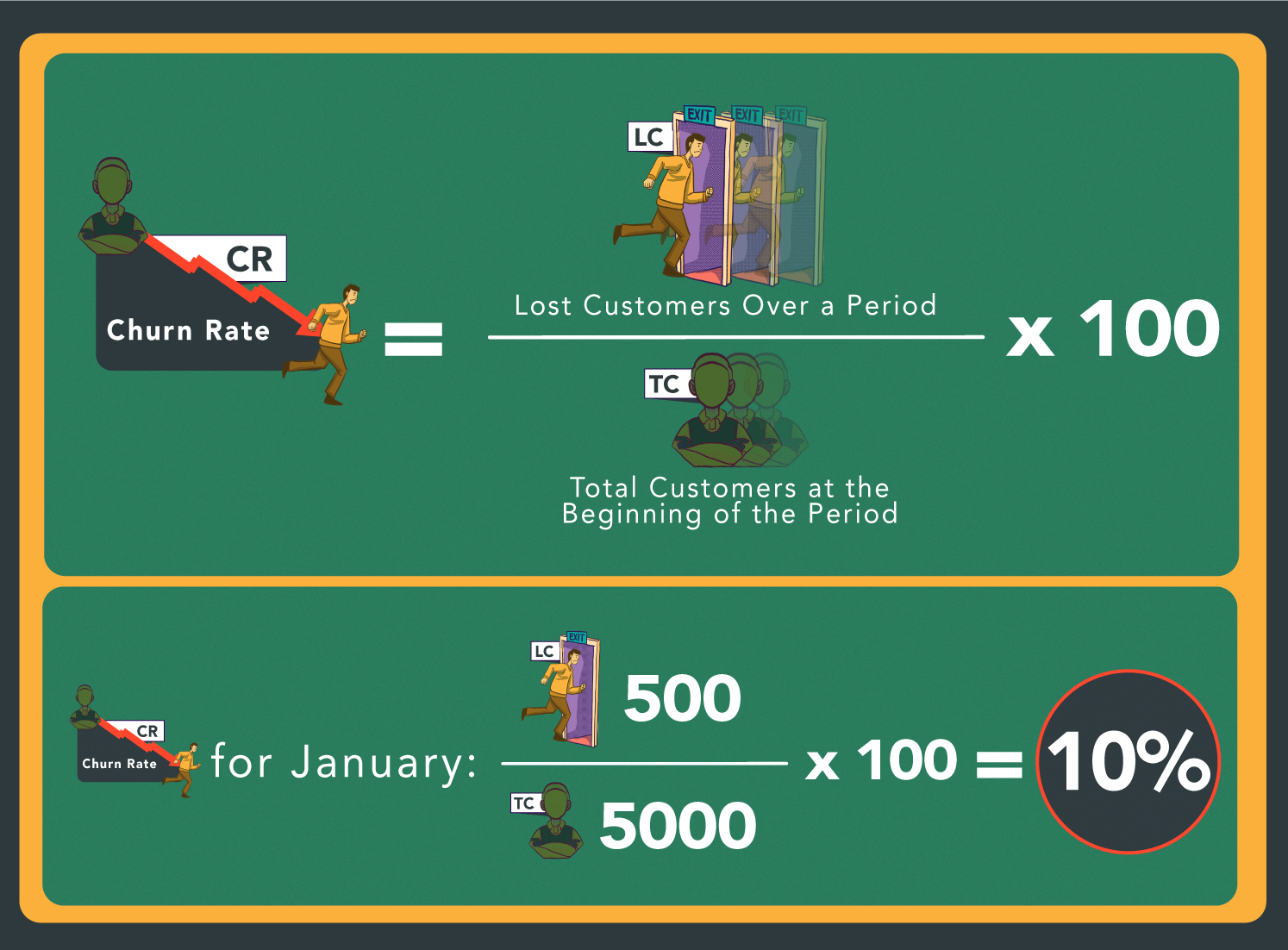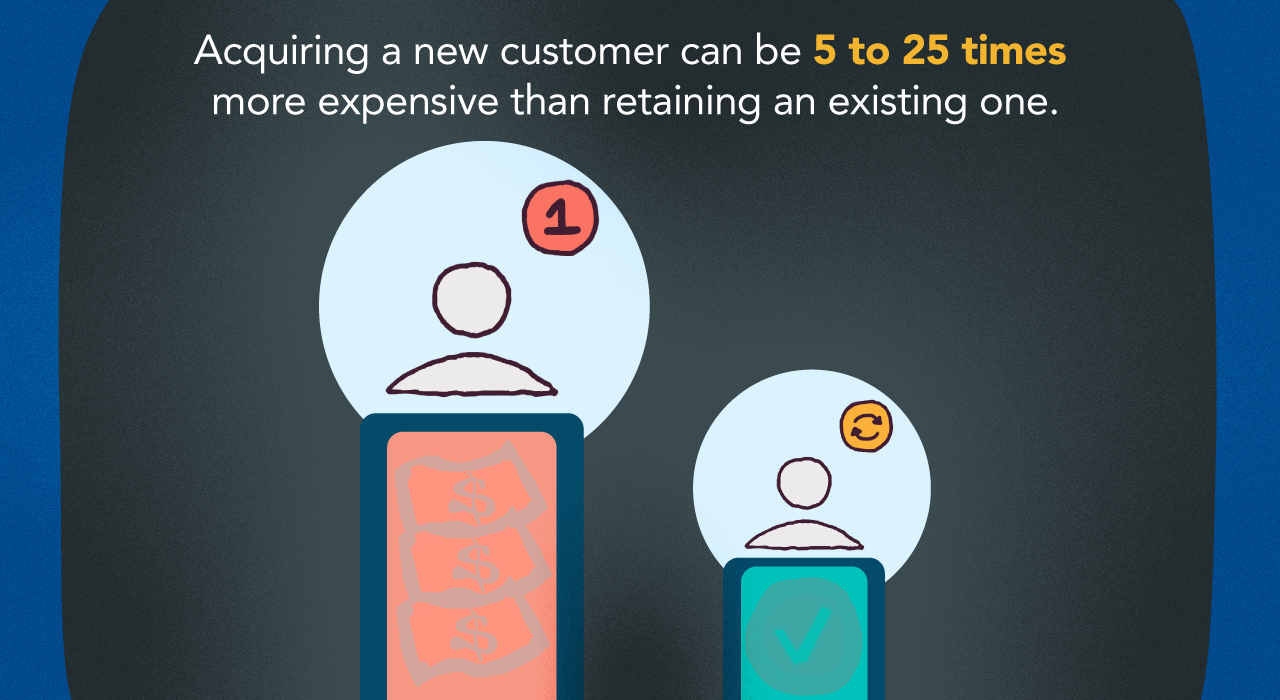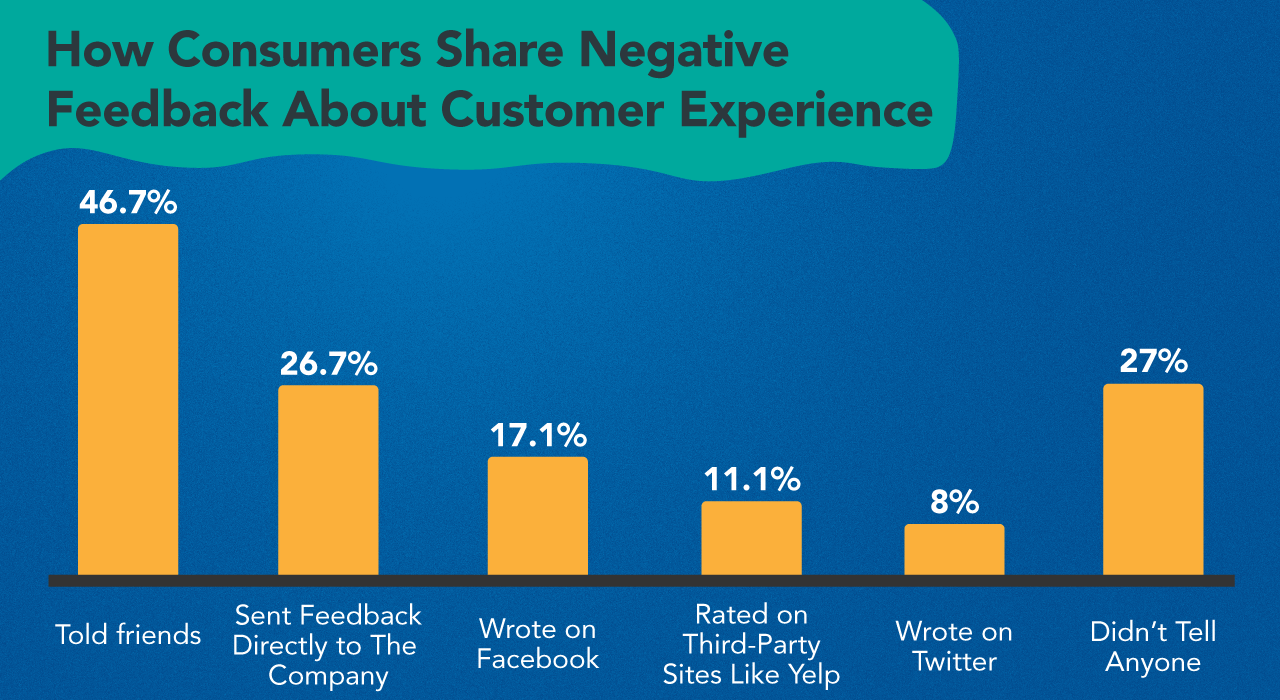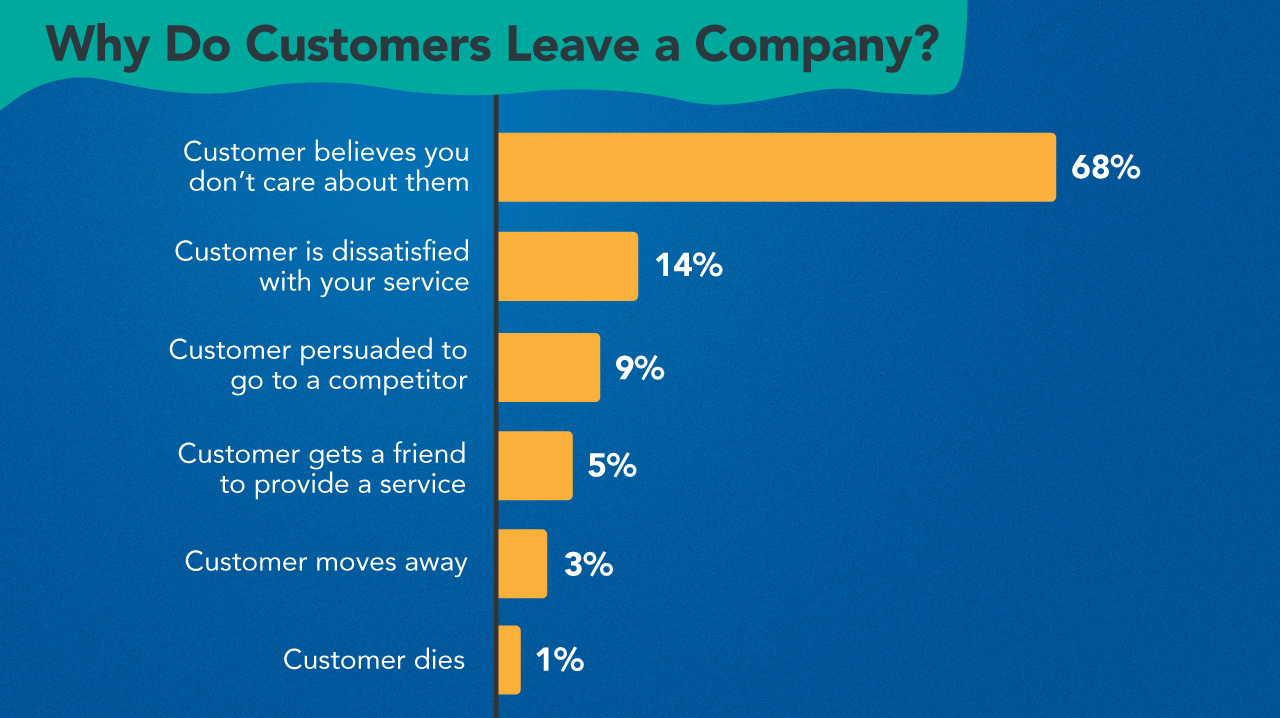Customer churn refers to when a person stops using your services or products and ceases to be a customer. It’s also known as customer attrition. The churn rate refers to the percentage of customers who stopped doing business with your company during a specific period.
Losing customers is a serious problem that impacts all industries. Companies must understand and analyze reasons and work proactively to reduce customer churn. Brands that are not tracking this metric would be wise to pay close attention because customer churn can cost companies to the tune of $136 billion per year.
The good news is that companies can use plenty of strategies for reducing customer churn. These include focusing on customer retention, customer experience, and customer service. In fact, 67% of churn can be avoided if companies resolve their customers’ issues on the first try.
Keep reading for an in-depth explanation of how to calculate and predict churn and, perhaps most importantly, how to reduce and prevent it.
- Understanding Customer Churn Rate + Modeling
- Why Does Churn Matter?
- Causes of Customer Churn
- Customer Churn Analysis
- Software for Managing Customer Churn
- 10 Ways to Manage and Prevent Customer Churn
- Infographic

Understanding Customer Churn Rate + Modeling
Customer churn rate is a metric that allows you to measure the number of customers lost within a given duration and document the progress over time. The formula for calculating the churn rate is as follows:
Churn Rate = (Lost Customers Over a Period / Total Customers at the Beginning of the Period) x 100
The best way to understand the formula is to see it in action.
Example:
Let's imagine your business had 5,000 customers at the beginning of January and 4,500 at the end of January. You lost 500 customers during that period.
Churn Rate for January: (500 / 5000) x 100 = 10%
Your customer churn rate is 10%.
Before you declare a customer lost, it's important to determine when you consider that a customer has churned. This varies from industry to industry as sales cycles for specific markets will be longer than others.
For example, someone that wears contact lenses would likely make repeat purchases at an optician, whereas someone that buys a sofa or a dining table would obviously not buy with the same frequency.

Why Does Churn Matter?
For any business, some customer churn is expected. Not all of your customers will stay with you forever. However, customer churn becomes a reason for concern if the rate gets high or shows an upward trend. Here are a few reasons you should keep an eye on customer churn.
- Churn Can Hinder Future Growth: If you have a high churn rate, your future plans may not come to fruition. For example, if you're planning to launch new services or products, you can count on the customers you already have both as buyers and natural promoters. Loyal customers are seven times more likely to try a new product or service launched by you. They are also five times more likely to buy from you again and forgive you for mistakes and four times more likely to refer you to their friends and family.
- Customer Churn is Expensive: Acquiring a new customer can be anywhere from 5 to 25 times more expensive than retaining an existing customer. It makes a lot more sense to nurture and maintain a relationship that already exists than to start from zero.
- Unhappy Customers Can Impact Your Brand Negatively: Customers that churn are likely unhappy. They are more likely to speak badly about your brand, leave negative reviews or share their poor experience with others. If you can identify those existing customers that look like they're going to leave, it would be wise to repair those relationships if possible. Statistics show that people are more likely to share bad experiences rather than good ones.

Causes of Customer Churn
There are many reasons customers stop doing business with you; some you can control while others are out of your hands.
Voluntary churn refers to when customers decide to leave on their own. It could be due to a poor experience with your company or a more attractive offer from a rival brand. Reducing this type of churn requires fully understanding the steps you need to take to improve customer satisfaction.
Involuntary, also known as delinquent, churn occurs when customers leave without actively choosing to do so. It’s most often seen in the SaaS industry and is usually attributable to a failure of the product.
Let’s look at some of the more common reasons for voluntary churn:
- You’ve priced your products or services incorrectly: Identifying precisely what your customers are willing to pay can be challenging, and as the market changes and competitors come onto the scene, your customers might decide to go with a different provider.
- Your renewal offers need to rework: Your renewal offers are missing something if your customers' subscriptions are coming to an end and your products or services aren't being renewed. It may very well be that your offers don't make the grade, especially when compared to those of your competitors.
- You don't understand your target market: Your customers’ needs will likely change over time, so it is crucial to keep your finger on their pulse. The best way to know what they're looking for is to engage with them regularly, read all of your customer feedback, and act accordingly.
- Your customer service is subpar: If you’re unable to provide a stellar customer service experience consistently, your customers will indubitably leave. Furthermore, they can share their experience with others, hurting your business. Make sure you’re proactive rather than reactive and handle customer issues quickly and efficiently while making every customer feel valued.
- You're over-communicating with your customers: When you contact your customers, make sure each message serves a purpose and provides value. When people feel like they're being spammed or receiving too many irrelevant emails from you, they are more likely to unsubscribe.
- There's a lack of brand loyalty: It's your responsibility to build a loyal customer base by delivering quality and value consistently and providing an unmatchable customer experience. When people see you and your competitors as interchangeable, they'll have no difficulty replacing you for any reason.

Customer Churn Analysis
Now that we understand what churn is, why it matters and what causes it, it’s time to do a churn analysis.
It’s essential to determine the issues driving churn to identify the right solutions. Similarly, if you've already implemented a solution, you need to assess whether they’re working or not so you can act accordingly.
There are two different methods for churn analysis: churn by customer behavior and cohort report.
- Customer behavior analysis: You can analyze churn by taking a closer look at how your customers are behaving. You want to identify any repeating patterns. You can also complete different functions on your website to see how seamless they are and determine if they impact the churn rate. This approach lets brands improve existing features of products and services better to retain customers and reduce attrition.
- Cohort report: This approach analyzes units of customers and their churn rate over time. Cohort refers to a segment of customers who made purchases from your company over a specific time frame. For example, you might have a January 2022 cohort, which will be all of the customers who bought from you in January.
When you use the cohort report approach, the numbers are not influenced by the acquisition of new customers. Hence, these numbers are more accurate and an easy way to identify patterns in churn.

Software for Managing Customer Churn
There’s no shortage of customer success software and customer relationship management software available to help you manage and reduce churn. Let’s take a look at some of your best options.
Churnly, for example, uses artificial intelligence to collect data from customers and accurately predict when they are most likely to churn, depending on the stage of the customer journey. It also allows users to identify patterns and discover reasons why a customer may leave so that the brands can take necessary action to retain them.
This tool also allows you to track activity and engagement, which are important indicators of how happy your customers are with your products and services. And it provides you inside information in terms of revenue at risk so that you can see the impact of customer attrition.
ChurnZero is also an excellent tool that provides overviews of everything from customer segmentation to customer journeys and offers real-time alerts and account insight. It also supports teams in driving more strategic customer conversations for boosting productivity and enabling sales representatives to scale their efforts and help more customers.
Another powerful customer retention tool comes with Zendesk Support. It is specifically a ticketing solution that helps companies learn, follow, and prioritize customer service problems. It supports the sales team and enables them to nurture a unified and consistent customer relationship management. Zendesk Support features include ticket forms, customizable ticket templates, dynamic content, and a satisfaction prediction tool.

10 Ways to Manage and Prevent Customer Churn
Although churn is inevitable, companies can apply plenty of strategies to manage and prevent high attrition. Keep reading for ten ideas you can implement right away.
1. Go Above and Beyond for Loyal Customers
Customers loyal to your brand will generally make regular purchases from your company. They may also leave good reviews and recommend you to colleagues, friends, and family.
You should go above and beyond to give them multiple reasons to remain loyal. These can include discounts on their birthday or special occasions, a reward or loyalty points system, exclusive/early access to new products or services, free items with multiple purchases, and preferential service terms.
2. Improve your Customer Effort Score (CES)
The Customer Effort Score measures the amount of effort it takes to use your products and services and how easy it is for customers to have their problems solved by customer service. Companies that understand how much effort it takes to interact with them can ensure that customers remain happy and their needs are met.
You can improve your CES by creating a seamless experience, anticipating problems and solving them preemptively, and reviewing feedback to identify actionable insight.
3. Give Priority to Customer Feedback
If you want to keep your customers from jumping ship, you've got to get inside their heads and understand what they're thinking. Ask for feedback and, most importantly, act on it.
But not just any feedback will do: You have to ask the right questions to get the right feedback so that you will be able to make informed, strategic decisions and implement changes where needed.
4. Provide Top-Notch Customer Service
Exceptional customer service drives customer loyalty. You can add value to your products and services by serving your customers so well that it makes it impossible for them to defect and buy from a competitor. If one in three customers say they will leave a brand after just one bad experience, there’s really no wiggle room when it comes to customer service.
Companies can provide top-notch service by being friendly, responding quickly, recognizing their mistakes, solving customers’ problems satisfactorily, and showing empathy and respect.
5. Understand the "Why" Behind the Churn
When customers stop doing business with you, you need to be proactive. Pick up the phone, call them, and ask them why they're no longer your customer. Not only does this show them that you're generally interested in them and in meeting their needs, but it also provides you with the quickest answers to your questions.
An overwhelming majority (68%) of customers say they churn because they believe that the company doesn't care about them. Show your customers that's not the case by reaching out personally.

6. Keep Your Customers Informed
The more information customers have at their fingertips, the easier it is for them to understand your products, services, and policies.
Make sure you have on your website a broad selection of support materials, FAQs, and educational videos and blogs to increase your customers’ knowledge. You can also offer tutorials, demos, webinars, and training to make your customers feel as supported as possible. All this content can be an excellent way to show them the potential of your products and services, making it easier to boost retention and reduce churn.
7. Highlight Your Competitive Advantages
In an increasingly crowded marketplace, it's important to stand out from the crowd. If your customers don't know what sets you apart from your competitors, what's to keep them from changing teams? Make sure your customers know about all of the competitive advantages they can enjoy when they do business with you. Highlight what makes you unique, so your customers know what they stand to lose if they decide to churn.
You can do this by investing in digital marketing to increase your brand awareness, consistently promote your unique selling points across your entire business, and support word-of-mouth marketing by encouraging brand advocates.
8. Use Top Talent to Deal with Disgruntled Customers
Saving customers on the verge of churning is a delicate art for which your company's most skilled representatives should be in charge. Identify your best and most convincing employees and let them talk to disgruntled customers, and resolve the most complex situations.
A rep who uses the right amount of experience, charisma, empathy, and active listening has the best chance of changing a customer's mind.
9. Track Your Net Promoter Score
If you've not been tracking this critical metric, it's time to start. The Net Promoter Score (NPS) allows you to identify your loyal customers, known as promoters, as well as dissatisfied ones, known as detractors.
The NPS reflects customer satisfaction and brand perception and essentially helps you understand if your customers are happy, if their opinions are shifting over time, and if any changes need to be made. Once you can gauge satisfaction or lack thereof, you can reduce the churn rate.
10. Provide an Unparalleled Customer Experience
The customer experience (CX) is an essential element that companies must consider to retain their clients and acquire new ones. When consumers feel fulfilled across every single touchpoint in their journey, you have a better chance of winning them over for life. When you maximize customer satisfaction, you boost your bottom line.
You can improve your CX by using technology to create unique customer experiences and an omnichannel approach to connect with people across different devices. You can also offer surveys with open text feedback to better understand your customers’ thoughts and feelings and personalize experiences, so customers feel special. Data shows that 80% of people are more likely to purchase when brands personalize the experience.
Customer churn is a serious problem that companies need to address as market competition and customer acquisition costs increase. With the right tools, churn can be analyzed and predicted.
Are your customers leaving because of pricing, poor customer service, or communication issues? To understand churn, it’s essential to find the root causes. Only then can you take the correct actions and expect to see a decline in attrition.
Infographic




